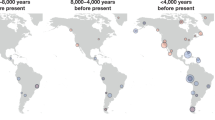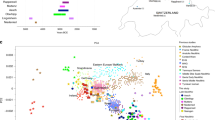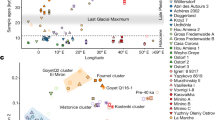Abstract
Genetic studies have consistently indicated a single common origin of Native American groups from Central and South America1,2,3,4. However, some morphological studies have suggested a more complex picture, whereby the northeast Asian affinities of present-day Native Americans contrast with a distinctive morphology seen in some of the earliest American skeletons, which share traits with present-day Australasians (indigenous groups in Australia, Melanesia, and island Southeast Asia)5,6,7,8. Here we analyse genome-wide data to show that some Amazonian Native Americans descend partly from a Native American founding population that carried ancestry more closely related to indigenous Australians, New Guineans and Andaman Islanders than to any present-day Eurasians or Native Americans. This signature is not present to the same extent, or at all, in present-day Northern and Central Americans or in a ∼12,600-year-old Clovis-associated genome, suggesting a more diverse set of founding populations of the Americas than previously accepted.
This is a preview of subscription content, access via your institution
Access options
Subscribe to this journal
Receive 51 print issues and online access
$199.00 per year
only $3.90 per issue
Buy this article
- Purchase on Springer Link
- Instant access to full article PDF
Prices may be subject to local taxes which are calculated during checkout


Similar content being viewed by others
References
Wang, S. et al. Genetic variation and population structure in Native Americans. PLoS Genet. 3, e185 (2007)
Reich, D. et al. Reconstructing Native American population history. Nature 488, 370–374 (2012)
Rasmussen, M. et al. The genome of a Late Pleistocene human from a Clovis burial site in western Montana. Nature 506, 225–229 (2014)
Raghavan, M. et al. Upper Palaeolithic Siberian genome reveals dual ancestry of Native Americans. Nature 505, 87–91 (2014)
Neves, W. & Pucciarelli, H. The origins of the first Americans—an analysis based on the cranial morphology of early South American remains. Am. J. Phys. Anthropol. 81, 274 (1990)
Neves, W. et al. Early Holocene human skeletal remains from Cerca Grande, Lagoa Santa, Central Brazil, and the origins of the first Americans. World Archaeol. 36, 479–501 (2004)
Neves, W. A., Prous, A., González-José, R., Kipnis, R. & Powell, J. Early Holocene human skeletal remains from Santana do Riacho, Brazil: implications for the settlement of the New World. J. Hum. Evol. 45, 19–42 (2003)
González‐José, R. et al. Late Pleistocene/Holocene craniofacial morphology in Mesoamerican Paleoindians: implications for the peopling of the New World. Am. J. Phys. Anthropol. 128, 772–780 (2005)
Rasmussen, M. et al. Ancient human genome sequence of an extinct Palaeo-Eskimo. Nature 463, 757–762 (2010)
Raghavan, M. et al. The genetic prehistory of the New World Arctic. Science 345, (2014)
Gilbert, M. T. P. et al. DNA from pre-Clovis human coprolites in Oregon, North America. Science 320, 786–789 (2008)
Chatters, J. C. et al. Late Pleistocene human skeleton and mtDNA link Paleoamericans and modern Native Americans. Science 344, 750–754 (2014)
Jantz, R. L. & Owsley, D. W. Variation among early North American crania. Am. J. Phys. Anthropol. 114, 146–155 (2001)
Neves, W. A., Hubbe, M. & Correal, G. Human skeletal remains from Sabana de Bogota, Colombia: a case of Paleoamerican morphology late survival in South America? Am. J. Phys. Anthropol. 133, 1080–1098 (2007)
González-José, R. et al. Craniometric evidence for Palaeoamerican survival in Baja California. Nature 425, 62–65 (2003)
Sparks, C. S. & Jantz, R. L. A reassessment of human cranial plasticity: Boas revisited. Proc. Natl Acad. Sci. USA 99, 14636–14639 (2002)
Relethford, J. H. Apportionment of global human genetic diversity based on craniometrics and skin color. Am. J. Phys. Anthropol. 118, 393–398 (2002)
Patterson, N. et al. Ancient admixture in human history. Genetics 192, 1065–1093 (2012)
Lazaridis, I. et al. Ancient human genomes suggest three ancestral populations for present-day Europeans. Nature 513, 409–413 (2014)
Qin, P. & Stoneking, M. Denisovan ancestry in East Eurasian and Native American populations. Mol. Biol. Evol. (2015)
Green, R. E. et al. A draft sequence of the Neandertal genome. Science 328, 710–722 (2010)
Meyer, M. et al. A high-coverage genome sequence from an Archaic Denisovan individual. Science 338, 222–226 (2012)
Prüfer, K. et al. The complete genome sequence of a Neanderthal from the Altai Mountains. Nature 505, 43–49 (2014)
McVicker, G., Gordon, D., Davis, C. & Green, P. Widespread genomic signatures of natural selection in hominid evolution. PLoS Genet. 5, e1000471 (2009)
Gillespie, J. H. Genetic drift in an infinite population: the pseudohitchhiking model. Genetics 155, 909–919 (2000)
Coop, G. et al. The role of geography in human adaptation. PLoS Genet. 5, e1000500 (2009)
Moorjani, P. et al. The history of African gene flow into Southern Europeans, Levantines, and Jews. PLoS Genet. 7, e1001373 (2011)
Hellenthal, G. et al. A genetic atlas of human admixture history. Science 343, 747–751 (2014)
Sankararaman, S., Patterson, N., Li, H., Pääbo, S. & Reich, D. The date of interbreeding between Neandertals and modern humans. PLoS Genet. 8, e1002947 (2012)
Lawson, D. J., Hellenthal, G., Myers, S. & Falush, D. Inference of population structure using dense haplotype data. PLoS Genet. 8, e1002453 (2012)
Delaneau, O., Marchini, J. & Zagury, J.-F. A linear complexity phasing method for thousands of genomes. Nature Methods 9, 179–181 (2011)
Li, H. & Durbin, R. Fast and accurate short read alignment with Burrows–Wheeler transform. Bioinformatics 25, 1754–1760 (2009)
McKenna, A. et al. The Genome Analysis Toolkit: a MapReduce framework for analyzing next-generation DNA sequencing data. Genome Res. 20, 1297–1303 (2010)
Busing, F. M., Meijer, E. & Van Der Leeden, R. Delete-m jackknife for unequal m. Stat. Comput. 9, 3–8 (1999)
Reich, D., Thangaraj, K., Patterson, N., Price, A. L. & Singh, L. Reconstructing Indian population history. Nature 461, 489–494 (2009)
Robbins, R. B. Some applications of mathematics to breeding problems III. Genetics 3, 375–389 (1918)
Becker, R. A. & Wilks, A. R. Maps in S. AT&T Bell Laboratories Statistics Research Report [93.2] (1993)
Alexander, D. H., Novembre, J. & Lange, K. Fast model-based estimation of ancestry in unrelated individuals. Genome Res. 19, 1655–1664 (2009)
Acknowledgements
We are grateful to the Native American volunteers who contributed the DNA samples used to generate the new data reported in this study and to the Fundação Nacional do Índio (FUNAI, Brazil) for logistical support in sample collection. We thank W. Klitz and C. Winkler for sharing samples for whole-genome sequencing. We thank L. Fehren-Schmitz, Q. Fu, G. Hellenthal, A. Kim, I. Lazaridis, M. Lipson, I. Mathieson, D. Meltzer, P. Moorjani and J. Pickrell for comments and A. Tandon for technical assistance. We thank T. Ferraz and R. Bisso-Machado for assistance with DNA extraction for the genotyping of Brazilian samples. We performed whole-genome sequencing as part of the Simons Genome Diversity Project. Genotyping of the Brazilian samples was performed at the Children’s Hospital of Philadelphia and we particularly thank C. Hou for her support in this. M.C.B., T.H., M.L.P.-E. and F.M.S. were supported by Conselho Nacional do Desenvolvimento Científico e Tecnológico and Coordenação de Aperfeiçoamento de Pessoal de Nível Superior (Brazil). P.S. was supported by the Wenner-Gren foundation and the Swedish Research Council (VR grant 2014-453). D.R. was supported by US National Science Foundation HOMINID grant BCS-1032255, US National Institutes of Health grant GM100233, Simons Foundation Grant 280376 and the Howard Hughes Medical Institute.
Author information
Authors and Affiliations
Contributions
P.S. performed analyses. P.S., S.M., M.C.B., N.C., T.H., M.L.P.-E., F.M.S., N.P. and D.R. prepared datasets. P.S. and D.R. wrote the paper.
Corresponding authors
Ethics declarations
Competing interests
The authors declare no competing financial interests.
Additional information
Genome sequence data is available from (https://www.simonsfoundation.org/life-sciences/simons-genome-diversity-project-dataset/). New Affymetrix Human Origins array genotype data are available to researchers who send D.R. a signed letter agreeing to respect specific conditions (Supplementary Information section 1).
Extended data figures and tables
Extended Data Figure 1 Clustering analysis.
ADMIXTURE38 clustering analysis performed on the Affymetrix Human Origins data used in this study. To aid in visualization, we only show results for Native American samples and for selected samples from Eurasian populations.
Extended Data Figure 2 qpWave coefficients.
Weights from qpWave for Native American populations and for non-American outgroup populations. No weights are given for Yoruba and Cabecar, as they are used in the computation.
Extended Data Figure 3 Excess allele sharing between the Surui and the Onge.
a, Tests for excess shared derived alleles with the Onge in all possible comparisons of 8 Suruí and 10 Mixe individuals. All Mixe–Suruí comparisons show a positive skew whereas all Mixe–Mixe and Suruí–Suruí comparisons are consistent with 0. Lines correspond to one standard error in either direction. b, Random sequence or genotype errors cannot explain the affinity of the Amazonians to Australasians, as simulated increased errors in the Onge do not cause an increased affinity to Suruí.
Extended Data Figure 4 Signals of admixture as a function of proximity to functional regions.
a, The affinity of 16 Papuan high-coverage genomes to 2 Amazonian Suruí high-coverage genomes as a function of proximity to regions of functional importance (measured by B-value). b, A total of 395 tests of quartets D(Yoruba, X; Y, Z) shows that quartets with significantly positive slopes (|Z| > 3) also yield significant genome-wide D-statistics of the opposite sign. This suggests that signals of admixture are systematically stronger close to functionally important regions.
Extended Data Figure 5 Linkage disequilibrium-based symmetry tests.
a, h4(Yoruba, X; Mixe, Suruí) for SNP pairs within 0.01 cM of each other contrasted with the fraction of SNP pairs in linkage equilibrium in population X (H = 0). Error bars show ± 1 s.e. b, Scatterplot of Z-scores for the f4- and h4-statistics for the same quartets. For both these panels we only use populations with at least 6 samples. c, d, We computed D(Yoruba, X; Y, Z) and h4(Yoruba, X; Y, Z) for many combinations of populations as X, Y and Z using phased Affymetrix Human Origins SNP array data ascertained in a Yoruba individual. Except for Africans who have ancestry from lineages that diverged before the Yoruba used for ascertainment and Oceanians (who have archaic Denisovan ancestry) we observe that |Z| > 3 h4-statistics are always associated with a significantly positive D for the same quartet. e, Correlation of the h4-statistic with the genetic distance separation of pairs of SNPs for h4(Yoruba, X; Mixe, Suruí).
Extended Data Figure 6 Admixture graphs for fitted population history models.
a, An admixture graph where all of Mixe, Suruí and Karitiana are of 100% First American ancestry is rejected with 6 predicted f-statistics at least 3 standard errors from the empirically observed value. b, An admixture graph where the ancestors of Suruí and Karitiana receive 2% ancestry from a lineage related to the Onge is consistent with the data with no outliers. c, An admixture graph where the distinct ancestry in Amazonians is more closely related to Han than to Onge produces 6 outliers. d, An admixture graph with no distinctive ancestry in Karitiana or Suruí but East Asian gene flow into the Mixe produces 7 outliers. e, An admixture graph with no distinctive ancestry in Karitiana or Suruí but MA1-related gene flow into the Mixe produces 6 outliers.
Extended Data Figure 7 Plausible range for the non-First American admixture proportion in Amazonians.
a, Range obtained assuming entirely First American ancestry in the Mixe. b, The maximum proportion of non-First American ancestry in the Mixe that is consistent with the data.
Supplementary information
Supplementary Information
This file contains Supplementary Text and Data 1-6, Supplementary Tables and additional references. (PDF 909 kb)
PowerPoint slides
Rights and permissions
About this article
Cite this article
Skoglund, P., Mallick, S., Bortolini, M. et al. Genetic evidence for two founding populations of the Americas. Nature 525, 104–108 (2015). https://doi.org/10.1038/nature14895
Received:
Accepted:
Published:
Issue Date:
DOI: https://doi.org/10.1038/nature14895
Comments
By submitting a comment you agree to abide by our Terms and Community Guidelines. If you find something abusive or that does not comply with our terms or guidelines please flag it as inappropriate.



